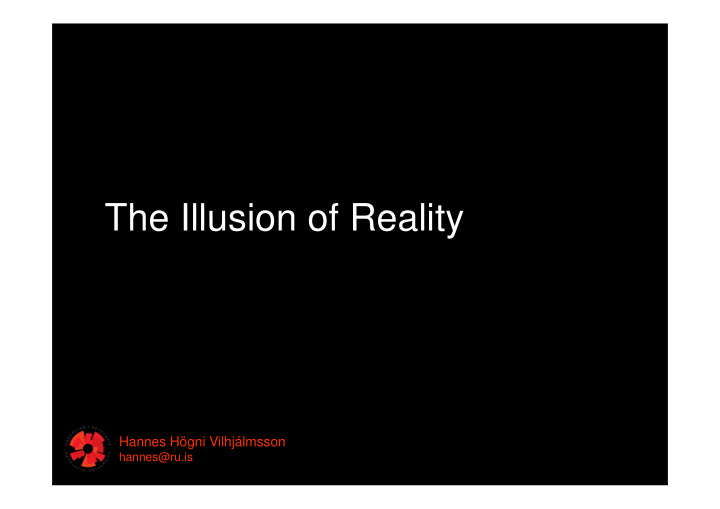



The Illusion of Reality Hannes Högni Vilhjálmsson hannes@ru.is
T H E I L L U S I O N • “Virtual reality works because reality is virtual” – Lawrence Stark, UC Berkeley
T H E I L L U S I O N • We experience a high-resolution spatial and temporal continuum when we look around the 3D environment we are in. • This is an illusion!
T H E I L L U S I O N • The retinal image of the visual field is in focus only in a very small area: The fovea.
T H E I L L U S I O N • We need to sample the visual field, with saccades and fixations (~3 per sec.) to construct an image.
what we see and scanpaths to „see“ more
T H E I L L U S I O N • Sampled information is relatively sparse when you walk into a room. You see the typical things and think you have seen the whole room.
T H E I L L U S I O N • You can change the way that you see by changing perceptual filters. • For example: “I want to see squares”...
“I want to see squares ”
“I want to see circles ”
T H E I L L U S I O N • Fixating ~90 % of the time. • Checking and rechecking points of interest, as if gathering support for what we think we are seeing. • It is hard to overcome strong presuppositions, such as what a room looks like...
... or what a vase looks like
T H E I L L U S I O N • We see what is in our mind’s eye, and use sampled visual information to verify this. • The scanpath is driven by our mental model. Change the model and the scanpath changes.
T H E I L L U S I O N • Our model can even make us see things that we don’t have any sensory data for!
T H E I L L U S I O N • That’s a good thing, because we are actually missing some data...
T H E I L L U S I O N • Can you find your blind spot?
T H E I L L U S I O N • Information is integrated across neighboring areas. • It’s image processing!
OF 3D WORLDS THE ILLUSION
3 D W O R L D S • How do we perceive immersion in a 3D environment?
3 D W O R L D S • How do we perceive immersion in a 3D environment? – Physiological cues – Stereoscopic cues – Static cues – Motion cues
convergence
accomodation
3 D W O R L D S • How do we perceive immersion in a 3D environment? – Physiological cues – Stereoscopic cues – Static cues – Motion cues
stereopsis
3 D W O R L D S • How do we perceive immersion in a 3D environment? – Physiological cues – Stereoscopic cues But even if we close one eye we see the world in 3D – how – Static cues can that be? (also on TV etc.) – Motion cues
3 D W O R L D S • How do we perceive immersion in a 3D environment? – Physiological cues – Stereoscopic cues – Static cues – Motion cues
interposition / occlusion
shading
shading
shading
brightness / lighting / color
size
linear perspective
texture gradient
3 D W O R L D S • How do we perceive immersion in a 3D environment? – Physiological cues – Stereoscopic cues – Static cues – Motion cues
motion parallax / head parallax
3 D W O R L D S • How do we perceive immersion in a 3D environment? – Physiological cues – Stereoscopic cues – Static cues – Motion cues
3 D W O R L D S • To sum up - Paint the 3D world into the mind of the receiver: – Build a mental model with expected behavior. – Address the expectations. – Avoid contradictions. – Build layers of strong consistent cues.
spot the cues?
texture gradient linear perspective size occlusion shadows color spot the cues?
Other interesting pictures...
Recommend
More recommend